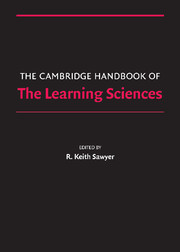Book contents
- Frontmatter
- Contents
- Preface
- Contributors
- 1 Introduction
- PART I FOUNDATIONS
- PART II METHODOLOGIES
- PART III THE NATURE OF KNOWLEDGE
- 14 Case-Based Reasoning
- 15 The Knowledge Integration Perspective on Learning and Instruction
- 16 A History of Conceptual Change Research
- 17 Spatial Representations and Imagery in Learning
- 18 Literacy and the Learning Sciences
- PART IV MAKING KNOWLEDGE VISIBLE
- PART V LEARNING TOGETHER
- PART VI LEARNING ENVIRONMENTS
- Afterword: After How Comes What
- Epilogue: The Fundamental Issue in the Learning Sciences
- Author Index
- Subject Index
- References
14 - Case-Based Reasoning
Published online by Cambridge University Press: 05 June 2012
- Frontmatter
- Contents
- Preface
- Contributors
- 1 Introduction
- PART I FOUNDATIONS
- PART II METHODOLOGIES
- PART III THE NATURE OF KNOWLEDGE
- 14 Case-Based Reasoning
- 15 The Knowledge Integration Perspective on Learning and Instruction
- 16 A History of Conceptual Change Research
- 17 Spatial Representations and Imagery in Learning
- 18 Literacy and the Learning Sciences
- PART IV MAKING KNOWLEDGE VISIBLE
- PART V LEARNING TOGETHER
- PART VI LEARNING ENVIRONMENTS
- Afterword: After How Comes What
- Epilogue: The Fundamental Issue in the Learning Sciences
- Author Index
- Subject Index
- References
Summary
In this chapter, I tell the story of case-based reasoning's contributions to the learning sciences. It is a story that begins in Artificial Intelligence and Cognitive Science in the 1970s. Roger Schank and his students were investigating ways for the computer to understand the everyday language we speak, and they were basing their work on observations about the way people seem to understand everyday language (Schank & Abelson, 1977). As part of those investigations, they were identifying schema-like knowledge structures that might organize different types of knowledge, and at the same time, identifying processes that could make inferences from those knowledge structures. Case-based reasoning (CBR) was born from this research in the 1980s as an attempt to make intelligent systems behave more like experts. As these researchers learned more about the processes that allow a reasoner to reason based on previous experiences, it became clear that case-based reasoning had much to offer education. Researchers began to use the principles of case-based reasoning to design learning environments, including adult education, museums, K–12 classrooms, and undergraduate education. Sometimes the computer has been integrated into those learning environments – as a tool that can provide the kinds of information and advice case-based reasoning says is useful for promoting successful project work and goal achievement, as a tool for eliciting the kinds of reflection that case-based reasoning says are important for learning productively from experience, or as an organizer of the learning sequence. Sometimes the computer has played little or no role.
- Type
- Chapter
- Information
- The Cambridge Handbook of the Learning Sciences , pp. 225 - 242Publisher: Cambridge University PressPrint publication year: 2005
References
- 9
- Cited by



